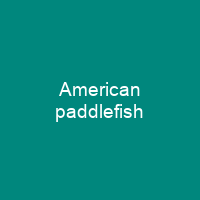The American Paddlefish: A Living Fossil
Imagine a creature that has been swimming the waters of North America for millions of years, unchanged since the time of dinosaurs. That’s exactly what the American paddlefish is—a living fossil with a fascinating history and unique adaptations.
The Evolutionary Journey
How did this ancient fish survive so long? The American paddlefish has a long fossil record dating back to the Early Cretaceous, making it one of the oldest species still in existence. Its evolutionary journey is marked by remarkable adaptations that have allowed it to thrive despite environmental changes.
A Unique Identity
The accepted scientific name for this fish is Polyodon spathula (Walbaum, 1792), named after its paddle-shaped rostrum. This distinctive feature has led scientists to classify it as a sister group to sturgeons, together forming the Acipenseriformes order.
Adaptations for Survival
The American paddlefish’s specialized adaptations are crucial for its survival. Its filter-feeding mechanism is highly derived, with gill rakers that have extensive comb-like filaments. These structures help it catch zooplankton efficiently, a diet that consists primarily of copepods, cladocerans, and ephemeropteran nymphs.
Electroreception: A Sensory Marvel
The paddlefish’s rostrum is covered with tens of thousands of sensory receptors. These electroreceptors can detect weak electrical fields signaling prey movements, allowing the fish to engage in ram suspension-feeding behavior. This unique ability is a testament to its evolutionary prowess.
Reproduction and Growth
How do American paddlefish reproduce? Females typically begin spawning at around seven to ten years of age, while males spawn more frequently, usually every year or every other year. They are broadcast spawners, releasing eggs into the water simultaneously with males releasing sperm for external fertilization.
Conservation Efforts
The American paddlefish is currently found in 22 states and is considered endangered due to overfishing, habitat destruction, and pollution. However, conservation efforts such as reintroduction programs have been implemented in Pennsylvania and New York, with some success reported.
Commercial Value and Challenges
The global commercial market for American paddlefish has expanded, with fish now raised in Europe, Asia, Ukraine, Germany, Austria, the Czech Republic, Bulgaria, China, and Romania. Despite these efforts, challenges such as zebra mussel infestations continue to affect their populations.
Conclusion
The American paddlefish is a remarkable species that has survived for millions of years. Its unique adaptations and evolutionary history make it a fascinating subject for study. As we continue to face environmental challenges, the conservation of such ancient creatures becomes increasingly important. Will you join in efforts to protect this living fossil?

You want to know more about American paddlefish?
This page is based on the article American paddlefish published in Wikipedia (retrieved on November 29, 2024) and was automatically summarized using artificial intelligence.






